Real-Time Human Pose Recognition in Parts from Single Depth Images:
Supplementary Material
Jamie Shotton
Andrew Fitzgibbon
Richard Moore
Microsoft Research Cambridge & Xbox Incubation
Mat Cook
Alex Kipman
Toby Sharp
Mark Finocchio
Andrew Blake
Figure 1. Differences in local appearance within one body part.
This supplementary material accompanies the paper
“Real-time Human Pose Recognition in Parts from Single
Depth Images” at CVPR 2011. It provides more detail on
the randomized synthetic rendering pipeline and further ex-
perimental results. Please also see the supplementary video.
1. Rendering pipeline
Even within a single body part there is considerable vari-
ation in appearance due to even just pose variation. Fig. 1
gives examples for the (screen-)right hand.
To account for this variation in the training data, we built
a comprehensive rendering pipeline of images of people
from which we randomly sample labeled training images.
The variations described below are the best approximation
we could reasonably achieve to the variations one expects
in the real world, including pose, clothing, camera noise,
etc. We cannot hope to sample all possible combinations of
variations. However, if samples contain independent vari-
ations (and we thus exclude artificial correlations such as
thin people always wear a hat), we can expect the classifier
to learn a large degree of invariance.
We now run through the variations.
Base Character We use 3D models of 15 varied base char-
acters, both male and female, from child to adult, short
to tall, and thin to fat. Some examples are shown in
1
Figure 2. Renders of several base character models. Top row:
without skinning. Bottom row: with random skinning of hair and
clothing.
Fig. 2 (top row). A given render will pick uniformly at
random from the characters.
Pose Having discarded redundant poses from the mocap
data, we retarget the remaining poses to each base
character, and choose uniformly at random. The pose
is also mirrored left-right with probability 1
2 to prevent
a left or right bias.
Rotation & Translation The character is rotated about the
vertical axis and translated in the scene, uniformly at
random.
Hair & Clothing We add mesh models of several hair
styles and items of clothing chosen at random; some
examples are shown in Fig. 2 (bottom row).
Weight & Height Variation The base characters already
have a wide variety of weights and heights. To add fur-
ther variety we add an extra variation in height ±10%
and weight ±10%. For rendering efficiency, this vari-
ation does not affect the pose retargetting.
Right hand appearances Base Character Models �
Figure 5. Number of Trees. (a) Quantitative results. (b) Qualita-
tive results.
Figure 4. True positive threshold vs. mean average precision.
Camera Position & Orientation The
height,
pitch and roll are chosen uniformly at random within a
range believed to be representative of an entertainment
scenario in a home living room.
camera
Camera Noise Real depth cameras exhibit noise. We dis-
tort the clean computer graphics renders with dropped-
out pixels, depth shadows, spot noise and disparity
quantization to match the camera output as closely as
possible. In practice however, we found this noise ad-
dition had little effect on accuracy, perhaps due to the
quality of the cameras or the more important appear-
ance variations due to other factors such as pose.
We use a standard graphics rendering pipeline to gener-
ate the scene, consisting of a depth image paired with its
body part label image. Examples are given Fig. 3.
2. Further Experimental Results
True positive threshold. We show in Fig. 4 the effect of the
threshold on true positives in our recall-precision metrics on
joint prediction accuracy in the synthetic test set. Even at a
tighter 6cm threshold our approach still gives an mAP of
about 0.5.
Number of trees. We show in Fig. 5 test accuracy as the
number of trees is increased, using 5k images for each depth
18 tree. The improvement starts to saturate around 4 or 5
trees, and is much less than the improvement by making
the trees deeper. The error bars give an indication of the
remarkably small variability between trees.
Definitions of body parts. The 31 parts used contain sev-
eral (e.g. LU arm) that do not map directly to the body joints
of interest. To investigate whether these ‘redundant’ parts
are useful, we trained a forest on 30k images where these
Figure 6. Training Efficiency. Curves shown are for 3 trees each
to depth 20 with 2000 features and 50 thresholds tested per node.
parts are merged. This results in a total of 17 body parts in-
cluding 16 ‘direct-joint’ parts and 1 merged part. The forest
gave an mAP of 0.554, considerably worse than the 0.685
for the original 31 parts. The reason for the drop is ap-
parent in the resulting images: the direct-joint parts bleed
a lot into the merged part, hurting localization. It appears
that the standard entropy objective used by random classi-
fication forests is unable to separate the merged part from
the 16 direct-joint parts, probably due to the imbalance of
their contributions to the objective function. Our carefully
designed body parts instead allow good localization giving
high accuracy even using standard RFs.
Training efficiency. We compare in Fig. 6 the efficiency of
training using a single machine and a large cluster. The ef-
ficiency of the distributed training algorithm is comparable
to a single machine implementation, and improves consider-
ably with the number of images. Various parameters of the
distribution could be adjusted to give a further efficiency for
a given number of images. Of course, the absolute training
time is also dramatically reduced.
Effect true positive threshold 0.00.10.20.30.40.50.60.70.80.90.000.050.100.150.20Mean average precision True positive distance threshold (m) 40%45%50%55%123456Average per-class accuracy Number of trees Synthetic test setReal test setNumber of trees 1 tree 3 trees 6 trees ground truth 2 tree 4 trees 5 trees (a) (b) 00.050.10.150.2101001000100001000001000000Training efficiency (core hours per image) Number of training images (log scale) 8 core machine1000 core clusterEfficiency vs Number Training Images �
Figure 3. Example training images. Pairs of depth image and ground truth body parts. See also Figure 2 in the main paper.
Number of features and thresholds. Fig. 7 shows the ef-
fect of the number of candidate features θ and thresholds
τ used during tree training on test classification accuracy.
Most of the gain occurs up to 500 features and 20 thresh-
olds.
In the easier real test set the effects are less pro-
nounced. These results use 5k images for each of 3 trees
to depth 18.
Further qualitative results. We show more classification
and joint prediction results in Fig. 8 on real images from
our structured light depth camera. In Fig. 9 we show more
results on the Stanford test set from their time of flight cam-
era.
Example chamfer matches. We illustrating in Fig. 10 the
quality of chamfer matches obtained for the comparison in
the main paper using 130k exemplars.
Tree node visualization.
In Fig. 11 we visualize how
the split functions recursively partition the space of human
body appearances as we descend the tree. Note how, as one
descends the tree, the patches become more specific, indi-
cating how the tree split nodes are separating different body
parts by distinguishing different appearances.
Example training images �
Figure 7. Effect of the number of features and thresholds on test accuracy.
Number of Features/Thresholds 42%44%46%48%50%52%54%0500100015002000Average per-class accuracy Number of candidate features θ Real test data; Uniformprobe proposalsSynthetic test data;Uniform probe proposals40%42%44%46%48%50%52%54%01020304050Average per-class accuracy Number of candidate thresholds τ Real test data; Uniformthresh. proposalsSynthetic test data;Uniform thresh. proposalsReal test set Synthetic test set Real test set Synthetic test set �
Figure 8. Qualitative results on real data. The top 7 rows use the ±120◦ classifier and show for each joint the most confident proposal,
if above a fixed threshold. The bottom 4 rows use the full 360◦ classifier and show the top 4 proposals above the threshold for each joint.
These results include six different individuals (four male, two female) wearing varied clothing at different depths. The system can even
reliably classify and produce accurate joint proposals for images containing multiple people. See also the supplementary video.
front side top input depth image inferred body parts front side top input depth image inferred body parts Example sequence results s1: 15, 160, 288, 382, 414, 436, 493, 544, 629 s2: 63, 81, 153, 173, 236, 265, 326 s3: 52, 60, 75, 92, 107, 243 s4 t1: 159, s4 t2: 192, 319, 449 s5 t1: 72, 156, 212, s5 t2: 126 inferred joint proposals inferred joint proposals �
Figure 9. Example results from the Ganapathi et al. test set. This test set contains one actor from a low fixed camera viewpoint (which
makes the actor appear to be leaning backwards). Our system can accurately localize body joints despite being designed for a different
depth camera. Quantitative comparison in main paper.
Example Stanford results 0, 90, 190, 440, 580, 730, 1120,1290,1760,2360,2520,3170,3590,3940 4040, 5070, 5180, 6390,7850 front side top input depth image inferred body parts front side top input depth image inferred body parts inferred joint proposals inferred joint proposals �
Figure 10. Chamfer Matches. In each pair, the left is the test image, and the right is the same test image overlaid with the outline of
the nearest neighbor exemplar chamfer match. Note the sensible, visually similar matches obtained using 130k exemplars. However, as
demonstrated in the main paper, joint localization is imprecise since the whole skeleton is matched at once.
Chamfer matching �
Figure 11. Visualization of a trained decision tree. Two separate subtrees are shown. A depth image patch centered on each pixel is
taken, depth normalized, and binarized to a foreground/background silhouette. The patches are averaged across all pixels that reached any
given tree node. The thickness of the edges joining the tree nodes is proportional to the number of pixels, and here shows fairly balanced
trees. All pixels from 15k images are used to build the visualization shown.
Views from particular nodes �
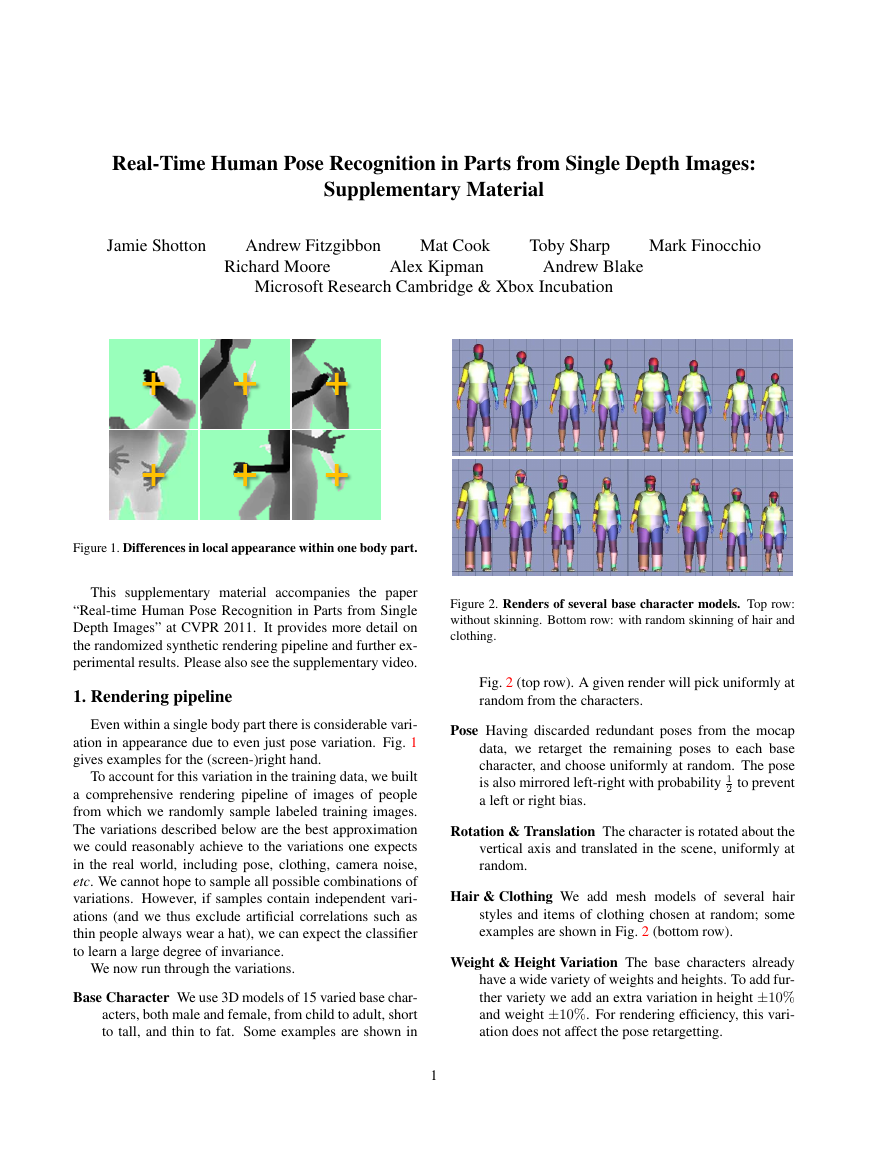
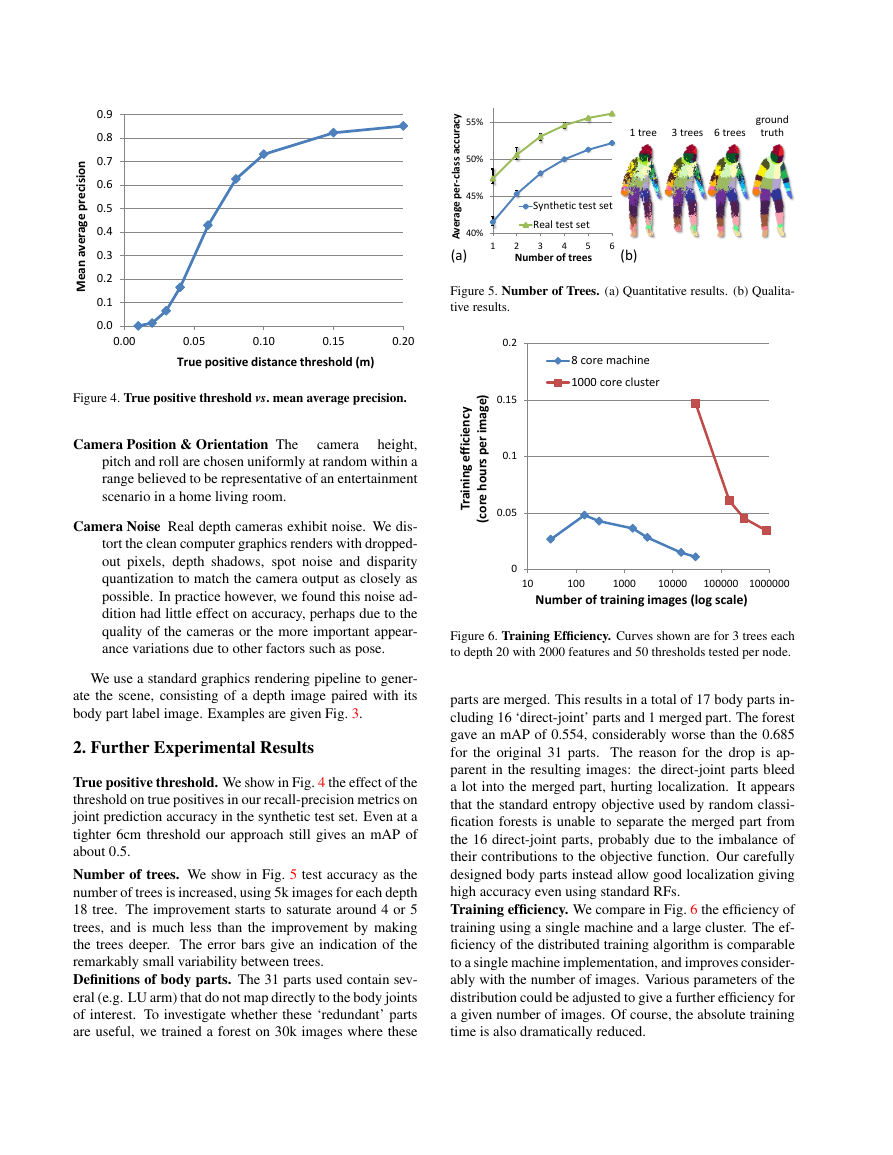

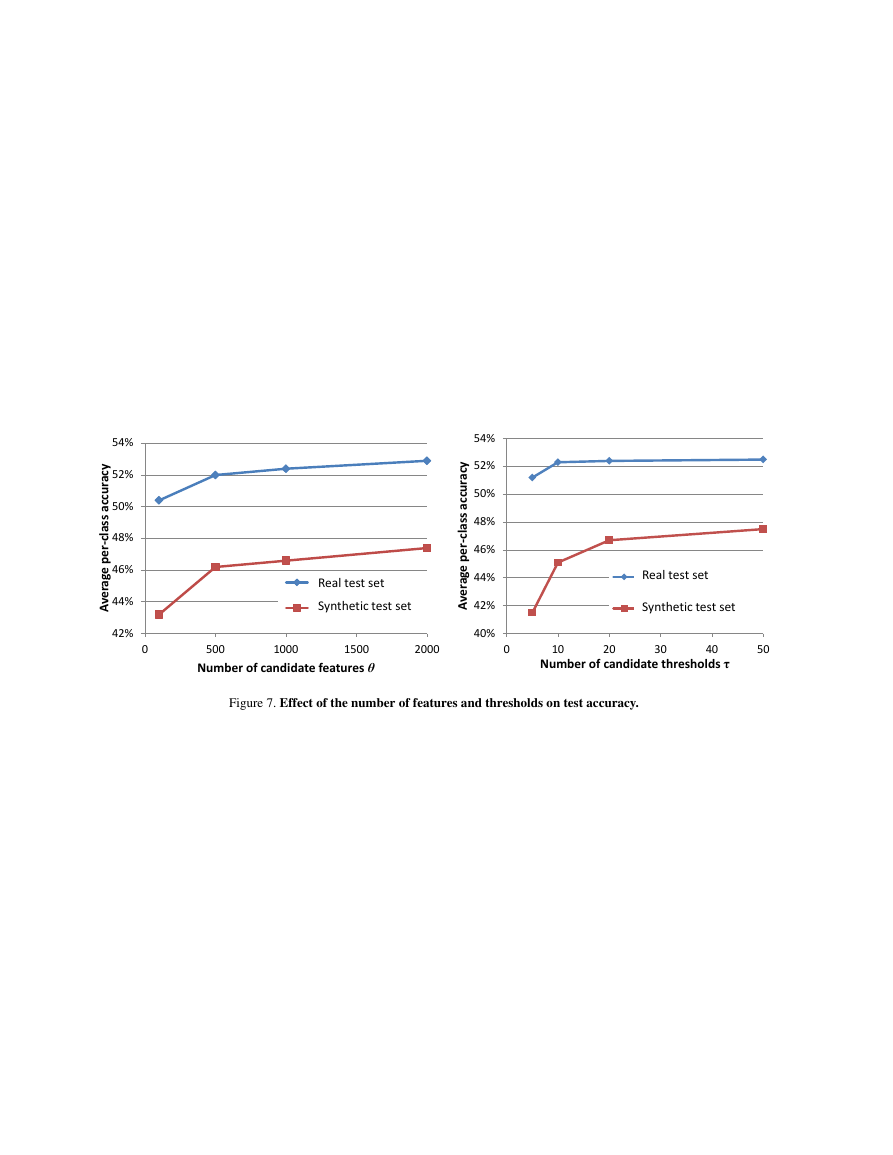
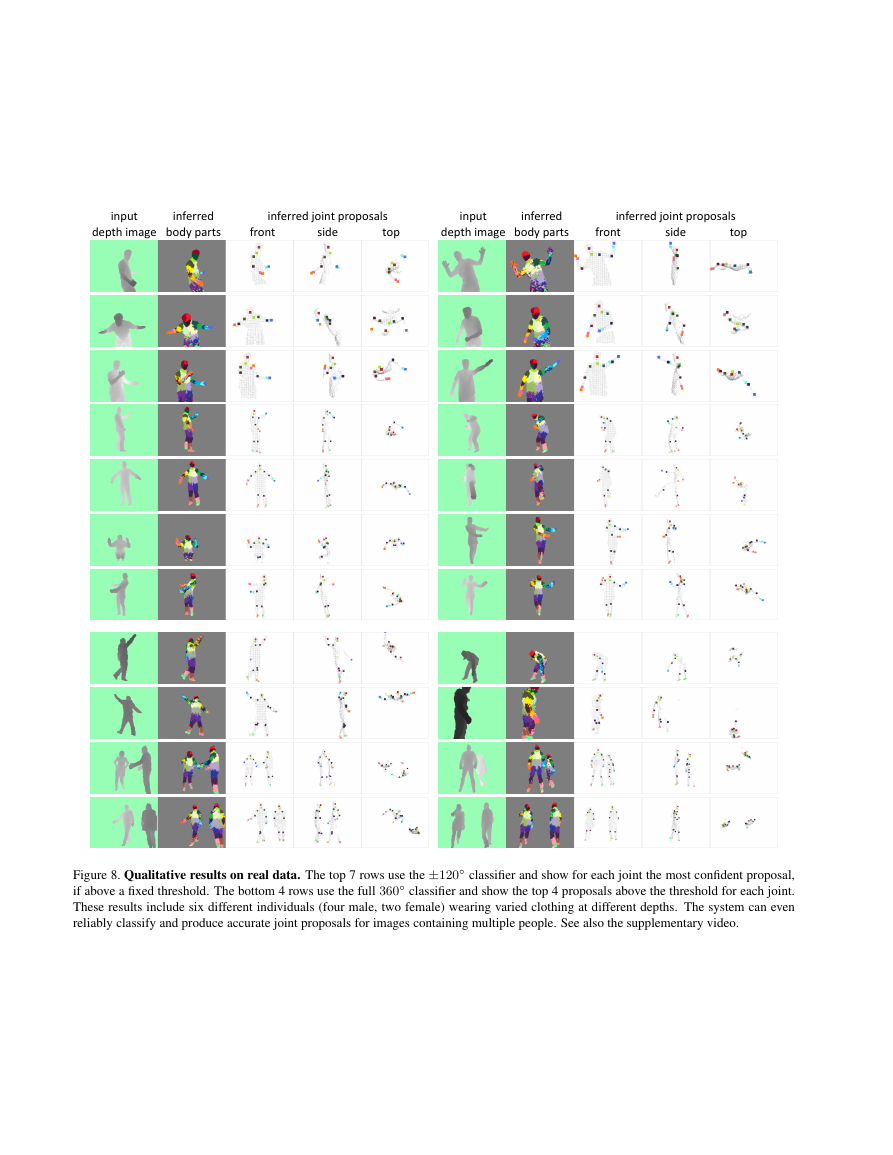
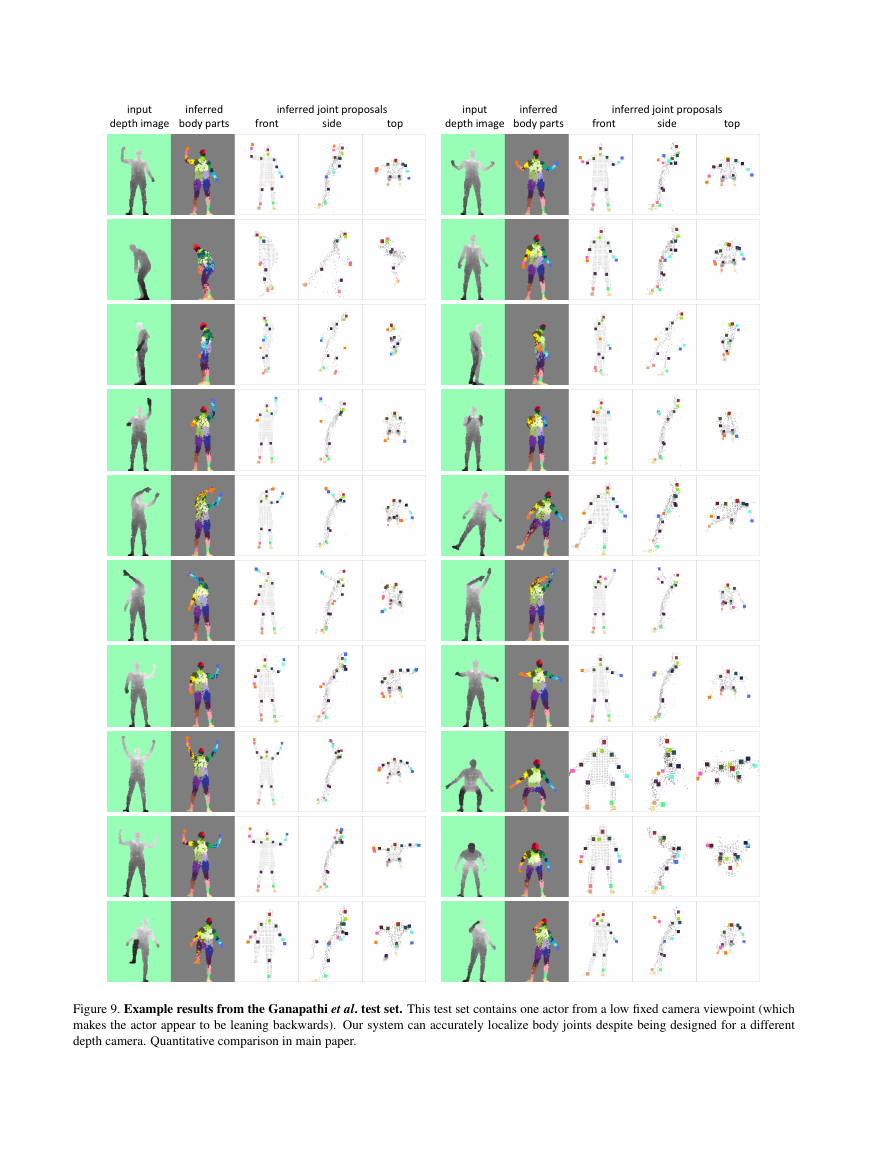
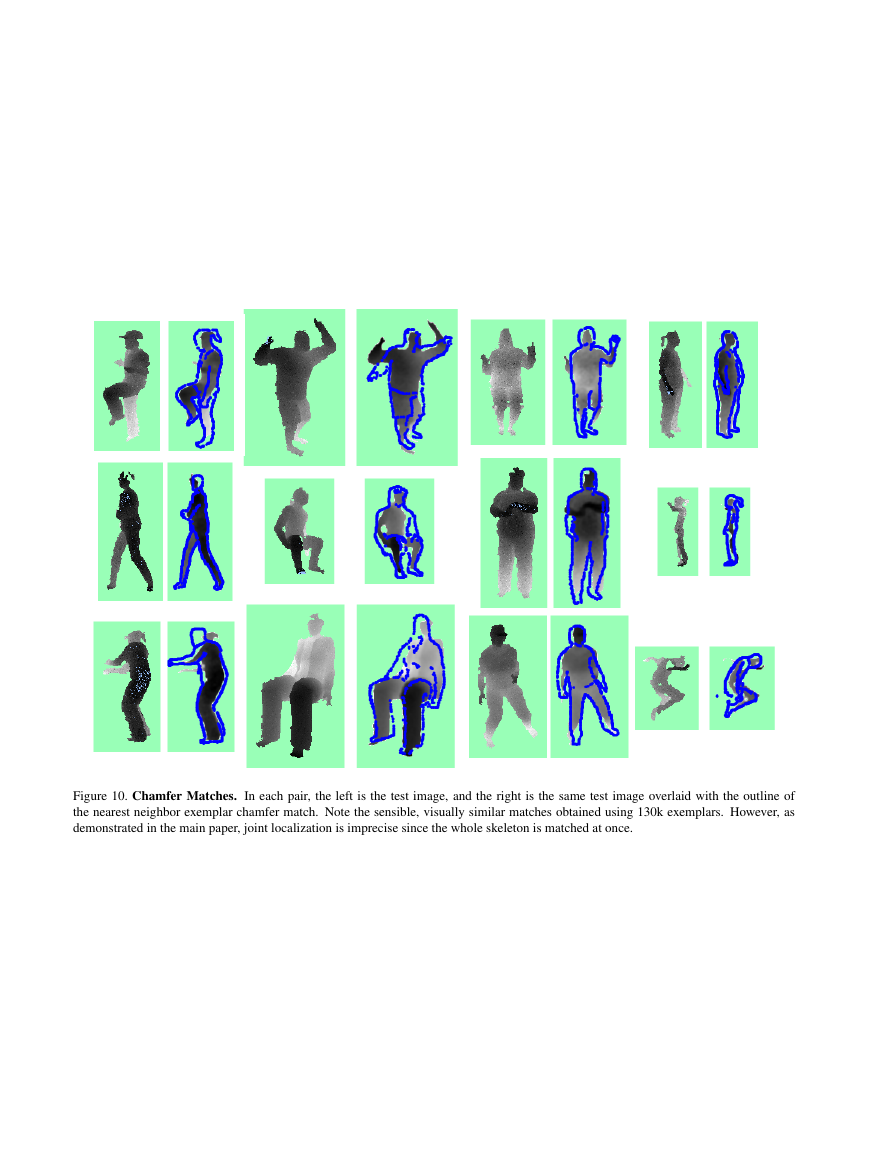
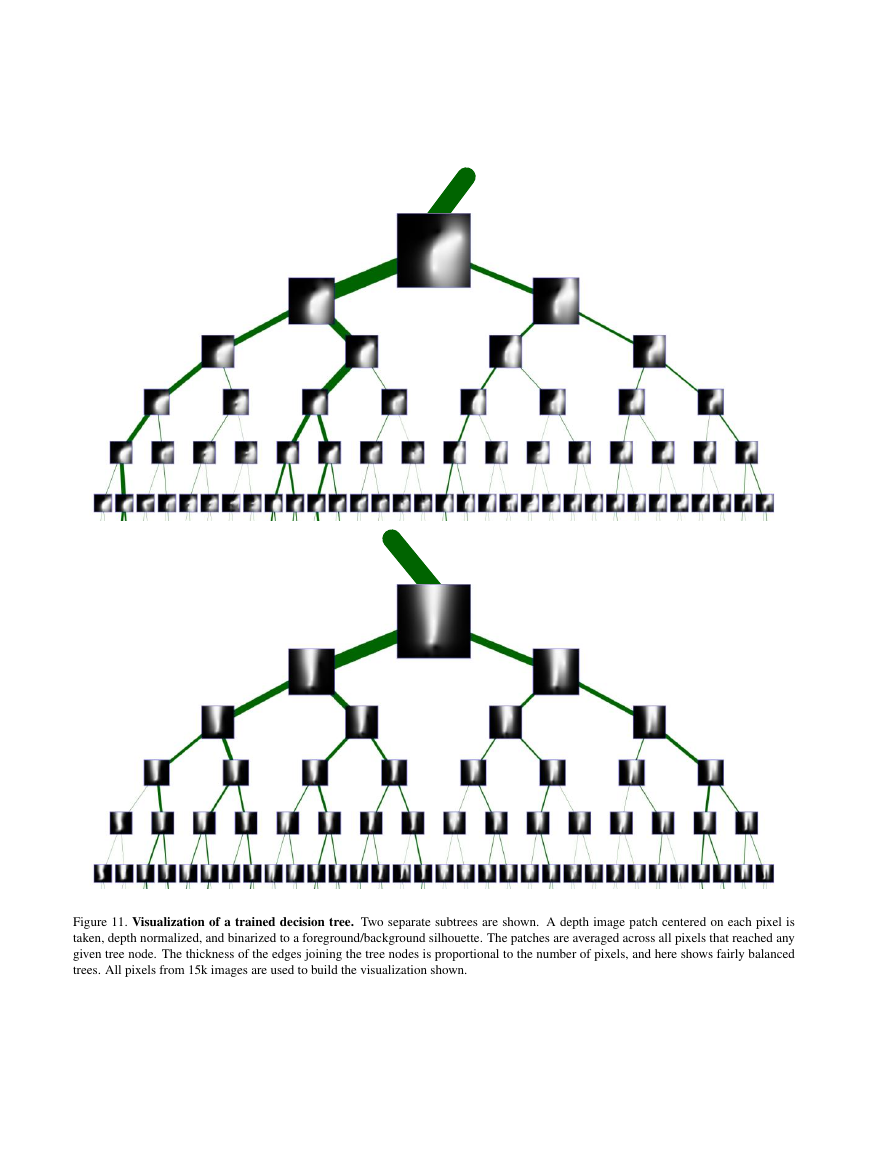








 2023年江西萍乡中考道德与法治真题及答案.doc
2023年江西萍乡中考道德与法治真题及答案.doc 2012年重庆南川中考生物真题及答案.doc
2012年重庆南川中考生物真题及答案.doc 2013年江西师范大学地理学综合及文艺理论基础考研真题.doc
2013年江西师范大学地理学综合及文艺理论基础考研真题.doc 2020年四川甘孜小升初语文真题及答案I卷.doc
2020年四川甘孜小升初语文真题及答案I卷.doc 2020年注册岩土工程师专业基础考试真题及答案.doc
2020年注册岩土工程师专业基础考试真题及答案.doc 2023-2024学年福建省厦门市九年级上学期数学月考试题及答案.doc
2023-2024学年福建省厦门市九年级上学期数学月考试题及答案.doc 2021-2022学年辽宁省沈阳市大东区九年级上学期语文期末试题及答案.doc
2021-2022学年辽宁省沈阳市大东区九年级上学期语文期末试题及答案.doc 2022-2023学年北京东城区初三第一学期物理期末试卷及答案.doc
2022-2023学年北京东城区初三第一学期物理期末试卷及答案.doc 2018上半年江西教师资格初中地理学科知识与教学能力真题及答案.doc
2018上半年江西教师资格初中地理学科知识与教学能力真题及答案.doc 2012年河北国家公务员申论考试真题及答案-省级.doc
2012年河北国家公务员申论考试真题及答案-省级.doc 2020-2021学年江苏省扬州市江都区邵樊片九年级上学期数学第一次质量检测试题及答案.doc
2020-2021学年江苏省扬州市江都区邵樊片九年级上学期数学第一次质量检测试题及答案.doc 2022下半年黑龙江教师资格证中学综合素质真题及答案.doc
2022下半年黑龙江教师资格证中学综合素质真题及答案.doc